WAP staff wishes all Antarcticians a Happy Easter celebration, with the hope that Holy Easter brings PEACE to the world


W.A.P. Worldwide Antarctic Program
WAP staff wishes all Antarcticians a Happy Easter celebration, with the hope that Holy Easter brings PEACE to the world

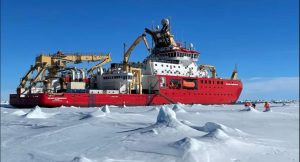 Climate researchers on board the RRS Sir David Attenborough have described their latest polar expedition as “really successful”.
Climate researchers on board the RRS Sir David Attenborough have described their latest polar expedition as “really successful”.
A team of 40 scientists, led by the University of East Anglia (UEA), have spent the last month conducting research in the Antarctic.
They have been investigating how carbon dioxide moves and transforms from the atmosphere into the Southern Ocean in the hope of improving models that make predictions about climate change.
Some of the work, such as operating underwater gliders, has been carried out remotely, almost 9,000 miles (14,500 km) at the UEA’s campus in Norwich.
Prof Karen Heywood, the UEA’s lead principal investigator, said her team had used “every scientific capability the ship had”. “We’ve been deploying instruments from the ship to profile the ocean, we’ve been collecting lots of water for analysing and we’ve been looking at how much krill there is,” she said.
Read more at: UEA scientists say latest polar research expedition ‘successful’ (bbc.com)
Thanks and credit to BBC
March 30, 1927 is an historical date, 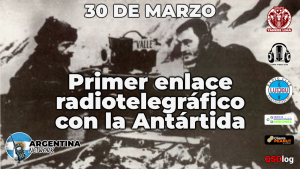 when the sounds of the Morse alphabet were heard for the first time in Antarctica; fundamental step in the development of communications at those latitudes, That day at the Meteorological Observatory of the South Orkney Islands, the Orkney Station (LRT) was officially inaugurated.
when the sounds of the Morse alphabet were heard for the first time in Antarctica; fundamental step in the development of communications at those latitudes, That day at the Meteorological Observatory of the South Orkney Islands, the Orkney Station (LRT) was officially inaugurated.
The Argentine Navy radio officer Emilio Baldoni first established contact from Antarctica with the LIK station in Ushuaia, the southernmost city in the world and through it, with Buenos Aires.
In the eleven nights preceding this event, from Laurie Island, where the Orcadas Base is located, the head of the expedition José Manuel Moneta, together with Miguel Ángel Jaramillo, Pedro Martín Casariego, Luis Falico and Conrado Becker, encouraged the radio operator Emilio Baldoni , who, pushing the key with his firm fist, repeatedly broadcast into the ether: “CQ… CQ…CQ… de LRT… LRT… LRT… Orcadas, Orcadas, Orcadas” , which in clear text, means “General call from South Orkney Islands… from Orkney Islands…”, followed by the text: “Answer very long calls to tune in… calling from South Orkney Islands….”
 When on that historic day, March 30, 1927, the Morse sounds of the letters were heard and repeated at rhythmic intervals: “LRT… LRT…”, everyone shouted in unison “We… We… Finally …Finally…”, the question was: Who is calling us? and immediately you could hear “LRT… LRT… de LIK… LIK… LIK…”; exclaiming all together “They’re calling us from Ushuaia.”
When on that historic day, March 30, 1927, the Morse sounds of the letters were heard and repeated at rhythmic intervals: “LRT… LRT…”, everyone shouted in unison “We… We… Finally …Finally…”, the question was: Who is calling us? and immediately you could hear “LRT… LRT… de LIK… LIK… LIK…”; exclaiming all together “They’re calling us from Ushuaia.”
Well, the rest of the extraordinary event, is history!
To celebrate the historical event, next March 30th from 00,00 UTC through March 31st at 23:59 (UTC international time) LU2CN, SERVICIO AUXILIAR DE RADIOAFICIONADOS DE LA ARMADA S.A.R.A. will carry out a CW activity to recall this historic event for Argentina.
.
A special certificate is available and will be issued for free to those who can make a contact.
WAP and Hams WW will be on air, for sure… we just hope the LUs operator can pay attention also to the Hams outside South America!
TNX: | SARA | QSL 97 años del primer enlace radiotelegráfico con la Antártida – QSLOG.AR
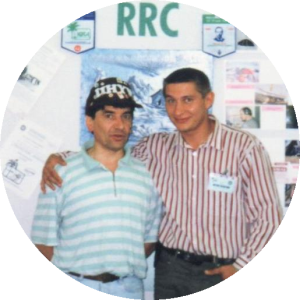 Ham Radio is something of incredibile!
Ham Radio is something of incredibile!
Being a radio amateur is certainly a privilege; Radio gives us the opportunity to travel the air, make connections all over the world, meet extraordinary people with whom growing lifelong friendships.
It’s the case of a friendship born more than 40 years ago, when for us, young Radioamateurs, looking for DX meant working the islands in the Arctic, the Antarctic bases, and proudly showing the QSLs confirming these contacts.
Well one of these friends, always active in the most remote places both in the Arctic and in Antarctica was and still is Valery Sushkov RW3GW, now RMØL!
 Valery Sushkov RMØL (ex RW3GW) is a travel researcher, postal historian, travel marketer, documentarian, chief postmaster of the International Philaturism Society, author of the new concept of “philaturism” in the history of world tourism practice, curator of the World Postal Mail Museum. Head of the Project “POSTVENTURE & Postal Adventure”. Visited more than 50 countries of the world, participant and organizer of more than 100 different expeditions on 6 continents, conqueror of the South
Valery Sushkov RMØL (ex RW3GW) is a travel researcher, postal historian, travel marketer, documentarian, chief postmaster of the International Philaturism Society, author of the new concept of “philaturism” in the history of world tourism practice, curator of the World Postal Mail Museum. Head of the Project “POSTVENTURE & Postal Adventure”. Visited more than 50 countries of the world, participant and organizer of more than 100 different expeditions on 6 continents, conqueror of the South 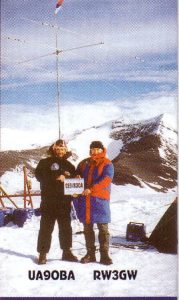 Pole and the highest peak in Africa – Mount Kilimanjaro, member of the Russian Geographical Society – Society for the Study of the Amur Region, member of the Union of Journalists of Russia, laureate and winner of the National Awards of the Russian Geographical Society “Crystal Compass”.
Pole and the highest peak in Africa – Mount Kilimanjaro, member of the Russian Geographical Society – Society for the Study of the Amur Region, member of the Union of Journalists of Russia, laureate and winner of the National Awards of the Russian Geographical Society “Crystal Compass”.
 Philaturism is educational and adventure tourism and the study of territories through the prism of philately and postal history, something new born from the fervent mondo f Valery!.
Philaturism is educational and adventure tourism and the study of territories through the prism of philately and postal history, something new born from the fervent mondo f Valery!.
For the development of philaturism, the project “POSTVENTURE & Postal Adventure” and the International Philaturism Community were created. Valery Sushkov RMØL (ex RW3GW) defines the project and community as a postal radio-telegraph historical adventure experiment. Together with like-minded people and partners, Valery Sushkov is implementing a project in the form of historical and postal reconstructions, special cancellation ceremonies, philaturist flash mobs, installation of postal monuments, the creation of postal routes and expeditions, philanthropic guides and philatelic products.
See: RM0M – Callsign Lookup by QRZ Ham Radio and https://www.rgo.ru/ru/article/master-klass-s-valeriem-sushkovym-filaturizm-novoe-ponyatie-v-mirovoy-praktike-turizma
 It’s a real shame! Six people visited Platcha Hut, a brand “New One” for many Antarctic Hunters, and nobody brought an HF Radio, to operate a little while from there, and living us the pleasure to log a rare spot in Antarctica!
It’s a real shame! Six people visited Platcha Hut, a brand “New One” for many Antarctic Hunters, and nobody brought an HF Radio, to operate a little while from there, and living us the pleasure to log a rare spot in Antarctica!
We just read the info posted today on FB page: «That’s one way to get to work! Expeditioners from Davis Research Station flew out to check in on the isolated Platcha Hut last week. The team of six got a lift from a helicopter that is currently at the station and had one of the most unique morning commutes in the AAP! »
There are a number of features close to Davis Station (WAP AUS-Ø3) which are the subject of regular recreational visits. These include Lake Dingle and Lake Stinear, the lakes nearest to the Station, Tarbuck Crag as the nearest high point, Weddell Arm for viewing Weddell Seals when appropriate, Ellis Rapids and Brookes Hut. Other field huts within the area, which are regularly used for recreational as well as scientific purposes are Platcha, Bandits, and Watts Lake Huts.
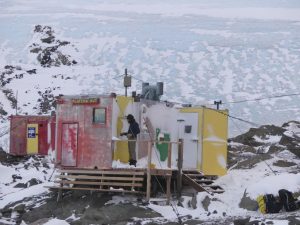 Platcha Hut 68° 30′ 47″ South, 78° 30′ 36″ East is situated in an extemely handy spot at the base of the plateau just to the south of Breid Basin a few metres above the shoreline. The locale is easy to reach by helicopter in the summer and is a decent walk over rough terrain from Davis Station for the keen. In the winter, Platcha Hut is one of the first to be visited once the sea ice forms and is thick enough. From Davis quads or Hägglunds, head along a waypointed route that follows Long Fjord to Breid Basin. The Hut itself sleeps four in bunk beds with room for two in the recently renovated (2011) Met Hut (the original Platcha) at the back.
Platcha Hut 68° 30′ 47″ South, 78° 30′ 36″ East is situated in an extemely handy spot at the base of the plateau just to the south of Breid Basin a few metres above the shoreline. The locale is easy to reach by helicopter in the summer and is a decent walk over rough terrain from Davis Station for the keen. In the winter, Platcha Hut is one of the first to be visited once the sea ice forms and is thick enough. From Davis quads or Hägglunds, head along a waypointed route that follows Long Fjord to Breid Basin. The Hut itself sleeps four in bunk beds with room for two in the recently renovated (2011) Met Hut (the original Platcha) at the back.
In the early 60s the original Hut was manned continuously by teams of two for a few weeks at a time. They were tasked with making meteorological observations.
 The present Platcha Hut was built in 1982. On the 9th of September the internal fit-out was transported to Platcha and by the 16th of September the hut was completed and ready for occupation which was a mammoth effort by the wintering team of 1982.
The present Platcha Hut was built in 1982. On the 9th of September the internal fit-out was transported to Platcha and by the 16th of September the hut was completed and ready for occupation which was a mammoth effort by the wintering team of 1982.
Thanks and credit to: Field huts around Davis – Australian Antarctic Program (antarctica.gov.au)
There are lots of Antarctic Hunters all over the world, who would love to work for the fist time on air Platcha Hut and for sure the other Huts scattered around the main Scientific bases in Antarctica.
From these pages, we, Radioamateurs launch an appeal to those responsible for scientific activities in Antarctica: Bringing a radio, setting up a couple of dipoles and doing a few hours of activity on HF is not just fun or recreation, but the study of radioionospheric propagation which could be part of the list of scientific experiments. Thank you
 Luis Risopatrón Refuge is an Antarctic Chilean refuge, located at 60°22’17” South, 59°42’53” West on the north shore of Coppermine Cove, Robert Island in Nelson Strait on South Shetland Islands
Luis Risopatrón Refuge is an Antarctic Chilean refuge, located at 60°22’17” South, 59°42’53” West on the north shore of Coppermine Cove, Robert Island in Nelson Strait on South Shetland Islands
The refuge lies 100 metres from the Antarctic Specially Protected Area ASPA No.112
Originally, it was called Coppermine Naval shelter and was inaugurated on March 20, 1949 by the Chilean Navy during the commission of Commodore Leopoldo Fontaine. By law No. 19087, enacted on September 24, 1991, the “shelter” was renamed Base Luis  Risopatrón, although, due to its characteristics it was known for quite a bit of time, as Luis Risopatrón Refuge. The shelter is located 40 m above sea level, on a solid rock surface, 150 m from the coast. 20 km from the closest base, Captain Arturo Prat, (WAP CHL-Ø1).
Risopatrón, although, due to its characteristics it was known for quite a bit of time, as Luis Risopatrón Refuge. The shelter is located 40 m above sea level, on a solid rock surface, 150 m from the coast. 20 km from the closest base, Captain Arturo Prat, (WAP CHL-Ø1).
The Base installation is made up of 5 modules. Scientific activities concerning terrestrial biology (since 1975) and geology and geophysics (since 1980) have been carried out there. The Base site, has a capacity for a staff of 12 people.
We must say that Risopatron Refuge should not be confused with the Luis Risopatrón Scientific  Antarctic Base, which did participate in the activities of the International Geophysical Year on March 3, 1957. This Base was set 60 meters from the O’Higgins Base (WAP CHL-Ø2) with civil resources belonging to the Catholic University of Chile.
Antarctic Base, which did participate in the activities of the International Geophysical Year on March 3, 1957. This Base was set 60 meters from the O’Higgins Base (WAP CHL-Ø2) with civil resources belonging to the Catholic University of Chile.
It was destroyed by fire on March 10, 1958, just a year after its opening.
.
WAP has no evidence of any recent Ham Radio operation from the Base or Refuge, whatever you want, while CE9AE seems to be (so far) the only one who did operate from the Base in 1957.
 Last march 10th 2024, the marathon for the “120th Anniversary” of Argentina’s presence in Antarctica has ended.
Last march 10th 2024, the marathon for the “120th Anniversary” of Argentina’s presence in Antarctica has ended.
It was not easy for EU to work the station active from the several LU Bases in Antarctica, as well as other callsign and Polar Ship involved, due to the operating GMT time non favorable for EU, but in spite of that, quite a few Hams did manage to work some!
Congrats to Estado Mayor Conjunto de las Fuerzas Armada, Comando Conjunto Antártico for the wonderful initiative. The marathon continue until the Antarctic campaign 2023-2024 will end; certificates are still available.
Not everybody has worked Icebreaker ARA Almirante Irízar yet, so our attention will now pointed on LU2AIB/MM, hoping to have this “new one” on the log as well, other than the pleasure to discharge the related certificate.
Look also for LU2ARM operating time to time, from the Joint Antarctic Command (EJERCITO ARGENTINO, DIRECCION ANTARTICA, in Buenos Aires, Capital Federal)
 All Digital Certificates, available to those who did work the Argentina’s Bases in Antartica and other official LU station which work within the event, could download their own confirmation by entering the QSLOG.AR website at:
All Digital Certificates, available to those who did work the Argentina’s Bases in Antartica and other official LU station which work within the event, could download their own confirmation by entering the QSLOG.AR website at:
QSLOG.AR – Bienvenidos!!! al Sitio Integrado de QSLOG.AR
TNX : Estado Mayor Conjunto de las Fuerzas Armada, Comando Conjunto Antártico
and
LU3IA Alfredo Arcangel Amaro (pic on the right) for his envaluable help and timely information on the activities of the various LU’s Antarctic stations.
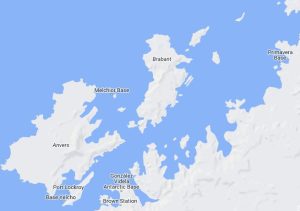 Brabant Island, lying off the west coast of the Antarctic Peninsula at 64°15’South, 62°20’West, is the second largest Island of the Palmer Archipelago within the British Antarctic Territory. Brabant Island, 59 km (37 mi) long north-south, 30 km (19 mi) wide, is lying between Anvers Island and Liège island. It had only been visited on six very brief occasions since its discovery in 1898, although a 1/200 000 topographic map had been produced in 1963 from FIDASE aerial photography.
Brabant Island, lying off the west coast of the Antarctic Peninsula at 64°15’South, 62°20’West, is the second largest Island of the Palmer Archipelago within the British Antarctic Territory. Brabant Island, 59 km (37 mi) long north-south, 30 km (19 mi) wide, is lying between Anvers Island and Liège island. It had only been visited on six very brief occasions since its discovery in 1898, although a 1/200 000 topographic map had been produced in 1963 from FIDASE aerial photography.
Joint Services Expedition explored the island in three phases over a 15-month period, from January 1984 to March 1985; each phase was landed and recovered by HMS Endurance. The aims of the expedition were primarily scientific and secondarily adventurous.
HMS Protector returned recently to Brabant Island for the first time since 2017 to continue work to remove abandoned equipment from the 1980’s expedition.
Royal Navy sailors have helped preserve the natural beauty of Antarctica by removing three tons of waste that had frozen into position but subsequent thaw and freeze cycles meant it could now be removed seven years on. Twenty-nine members of HMS Protector’s expedition headed ashore on the ship’s Zodiac boats. “It was quite shocking seeing all the mess left behind at first. But once we got together to gather up all the rubbish, we could instantly see the benefits of our work, quite a bitter-sweet”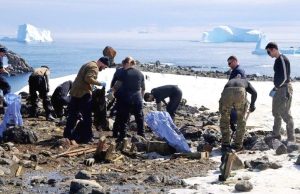
HMS Protector is the Royal Navy’s Polar Research ship and is currently deployed in the Antarctic region promoting British interests and enforcing the Antarctic Treaty by working with partners including the British Antarctic Survey (BAS), United Kingdom Antarctic Heritage Trust and the governments of the Falkland Islands, South Georgia and South Sandwich Islands.
TNX and credit: HMS Protector removes waste from Brabant Island next to Antarctica Peninsula — MercoPress
Well, maybe someone from the nearby Argentine Base Melchior (WAP ARG-13) can try to visit Brabant for a brief stay, or someone of the BAS can operate from there on one of the next visit!
Watch the Brabant Island Expedition Film 1983-85 here below
 As widely announced, last month of February, the 21st edition of the Antarctic Activity Week took place. (see: http://www.waponline.it/antarctic-activity-week/aaw-2024/)
As widely announced, last month of February, the 21st edition of the Antarctic Activity Week took place. (see: http://www.waponline.it/antarctic-activity-week/aaw-2024/)
All the participating stations with their own “Special Call” and the related WAP reference did report the large participation of radioamateurs and in many cases, they experienced a significant pile-up!
Many Hunters have already requested the certificate which, like every year, is offered free of charge to the participants, by our dear friend IK3GER Paolo Corsetti, whom we will never stop thanking.
An Antarctic diploma displayed in the shack of any DXer, makes a nice show and looks like a certification of a particular interest and, in the spirit of WAP, it demonstrates the sensitivity of radio amateurs towards scientific research and the love for a Continent like Antarctica, a land of study and PEACE.
The picture above, shows the diploma got by our friends Volker Strecke DL8JDX who did participate as Hunter in the 21st edition of the AAW 2023 which has just ended.